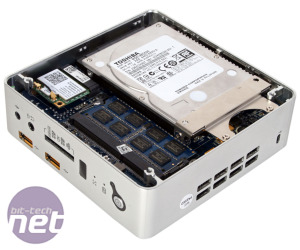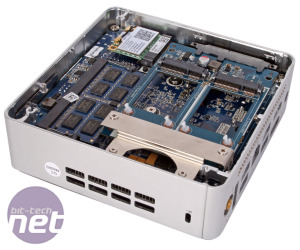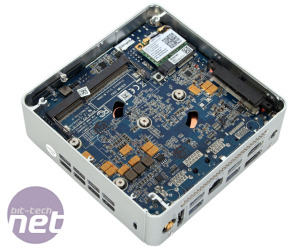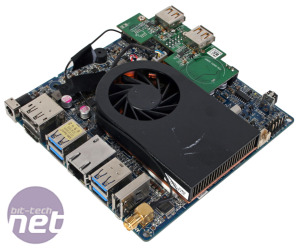
Interior
You need only a pair of hands to access the interior of the Zbox Nano ID65 Plus, as once you've twisted off the feet the bottom panel lifts straight off. This gives you immediate and easy access to the RAM and SATA connections, which is great for those who opt for the barebones ID65. You only get a single channel of memory, sadly, but Zotac has opted to fill it with a healthy 4GB stick that operates at 1,600MHz, the fastest supported by the HM77 Express chipset.As it tends to do with its Zbox PCs, Zotac also bundles a 500GB Toshiba MQ01ABD050 drive with the Plus models of the ID65, and this is a reasonable capacity to choose for a small media PC. The retail cost of a 4GB SO-DIMM 1,600MHz memory module and 500GB 2.5-inch hard drive is roughly £70, so the £75 premium for the ID65 Plus over the barebones package is fair. That said, users may want to consider that it would only cost £20-£25 more to double both the RAM and hard drive capacities, which would make for an even more attractive system.


Click to enlarge - The ID65 Plus with its default memory and hard drive (left) and the nanoRAID daughterboard installed (right)
Barebones users and upgraders also have the very viable option of installing an SSD thanks to the full SATA 6Gbps connection, and this could make for a very speedy media companion to a NAS set-up. Zotac also bundles what it calls a nanoRAID daughterboard, which effectively turns the SATA connection into a pair of mSATA connections. You can then set up a pair of mSATA SSDs in RAID configurations using the onboard BIOS (sadly there aren't any overclocking options). While this is only likely to be used by a few people, it's still a neat addition.
With a screwdriver to hand you can also remove the back panel and then slide out the motherboard. Flipping this over reveals the blower style cooler, similar to many found on graphics cards and laptops, with a copper baseplate and aluminium fins. The single tiny fan on it is responsible for keeping all system temperatures in check. Airflow is always going to be tricky in so small an enclosure, and that's indeed the case here. Cool air is taken in through small slits on the chassis floor as well as the back panel ventilation. It then needs to be drawn through the lower section where the memory and hard drive rest, into the fan and finally across the heatsink and out the side of the case.
Beneath the cooler sits the heart of the system, an Intel Core i7-3537U. This is a 22nm dual core Ivy Bridge part that sits in the ultra-low power category with a TDP of just 17W. It's clocked at a reasonable 2GHz, but also has maximum single and dual core Turbo frequencies of 3.1GHz and 2.9GHz respectively. As well as Turbo Boost, the chip also supports Hyper Threading.
With the onboard Intel HD Graphics 4000, the Core i7 CPU is also responsible for graphics processing. Its base clock is just 350MHz, although it does have a maximum dynamic frequency of 1.2GHz. It's an upgrade on the graphics front over the Zbox ID89 Plus, which only features HD Graphics 2500, but with only 16 execution units, the Nano ID65 Plus is still very much a media-oriented mini-PC than a gaming one.

MSI MPG Velox 100R Chassis Review
October 14 2021 | 15:04










Want to comment? Please log in.